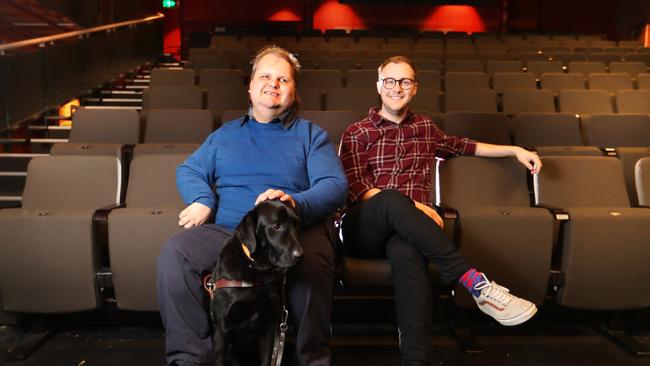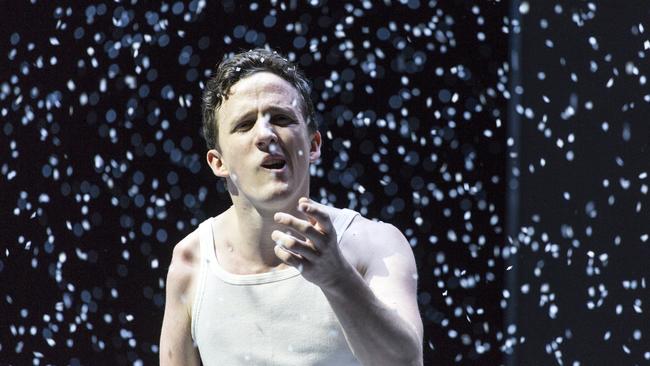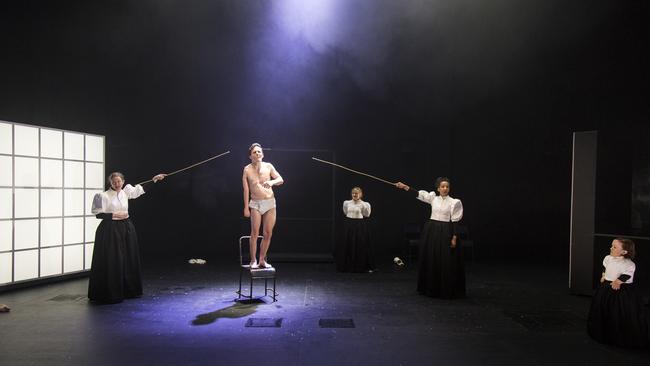Making sense of the stage: audio services with Description Victoria
For theatregoers with impaired vision, audio description services help to make sense of what’s happening on stage.

You are sitting in the front row of a theatre when a calm, male voice begins to speak into your ear, welcoming you and setting out key details about the play you are here to see. “The Merlyn theatre is a flexible, black-box theatre space,” says the voice. “For Elephant Man, the audience sits in a rectangular seating bank opposite to the stage. The stage is raised about 40cm off the ground, and takes up the full width of the Merlyn, about 10m wide.”
You are listening intently to the voice because you cannot see what it is describing. You are blind, but you love going to the theatre, and you want to better understand the performance beyond the dialogue that all attendees can hear from the stage. This is why you are at the Malthouse Theatre in Melbourne’s inner city on a rainy Friday night, listening as the shape and layout of the stage begins to take shape in your mind’s eye.
“A black proscenium arch frames the playing area, about 5m tall, creating a wide rectangular space,” continues the voice.
“A curtain of black gauze covers the entire width of the stage at its front edge, separating us from the playing area. We can see through the sheer material, but it softens the edges of everything behind it.”
You are hearing the voice because your earphones are connected to a wireless radio receiver that sits inside the palm of your hand. Later, this wonderful technology will allow you to follow the action you can’t follow with your eyes.
While the boisterous audience take their seats behind you in the minutes before a performance of The Real and Imagined History of the Elephant Man begins, you are listening to pre-show notes that are being broadcast into your ears from the green room on the building’s third floor. There, a bespectacled 26-year-old named Will McRostie sits before a computer, a live video feed of the stage, and some audio equipment that allows him to speak into the ears of theatregoers who have registered for audio description services this evening.
“The play makes extensive use of smoke and haze effects,” says McRostie’s voice. “Nozzles emitting smoke are hidden in the walls of the set, sometimes leaking heavy mist that tracks along the ground, and sometimes blasting plumes of light smoke that billows to fill the space. Two powerful fans set into the floor of the space are sometimes activated to catch this smoke and propel it toward the ceiling. On occasion, the smoke is so heavy it becomes difficult to see the performers.”
Difficulty in seeing the performers is the entire purpose of audio description, a niche and little-known service that is sometimes — but not often — available for people with low vision who attend theatres and cinemas. Because of its exclusivity and the resources required to produce the service, it is usually available only in Australia’s capital cities, and only for the biggest productions on the annual theatre and cinema calendars.
To date, audio description has largely been provided in an ad hoc manner by volunteers and, as a result, the quality of the service experienced by blind patrons can vary wildly. McRostie is at the forefront of a movement to professionalise it, however, which is why he founded an arts start-up named Description Victoria in March this year.
The services he provides this evening might be described as a vignette within a much bigger scene. There are about 260 people in attendance to witness tonight’s performance of a three-week run, but McRostie is not performing for them.
Instead, he is performing for an audience composed of just three people who are blind. These three are the only patrons inside the Merlyn who are even aware of McRostie’s existence, yet to them his role is of the utmost importance. Other than the actors and their formidable command of the spoken word, to them he is the most essential man in the building.
His measured, evocative voice is a lifeline to what sighted people take for granted: namely, going to the theatre on a rainy Friday night and being able to observe the actors on stage and see their facial expressions as they perform and interact, in accordance with the screenplay and direction.
By describing The Real and Imagined History of the Elephant Man to his small audience, McRostie helps to give meaning, provide context, and use language in a way that seeks to close the gap between how blind and sighted people experience the performing arts.
Audio description is devoted to improving theatregoers’ understanding of what takes place on stage, by filling in the blanks that dialogue cannot. Sometimes, this involves not just sitting passively in the front row, but getting hands-on with the performers and their tools of the trade.

About an hour before the lights dim in the Merlyn theatre, McRostie meets two of the three blind patrons in the foyer to guide them backstage for what’s known as a tactile tour. With help from his black guide dog, Varek, Ross de Vent cautiously edges up a ramp behind the stage, while Ramona Mandy grasps the arm of her partner, John. As a Malthouse stage manager watches on, McRostie introduces them to the space and skilfully leads them around where the action will take place, pausing to note the dark gauze material that separates the audience and performers.
“A lot of this play is set in a hospital,” he explains. “The effect softens the edges of everything seen behind it on the stage.”
When Mandy asks whether the gauze is permanently in place throughout the 90 minutes, McRostie smiles and responds: “It does retract at one point during the show. It’s removed as a bit of an effect, and I’ll let you know when that happens.”
Tactile tours such as this are wonderfully helpful for blind patrons to better understand the dimensions and dynamics of each performance. Mandy and de Vent are shown the vents lodged in each charcoal-painted wall which pump out stage smoke at key moments, and they stand on floor grates with fans beneath, that help to blast smoke toward the ceiling.
“Oh, wow!” says Mandy, eyelids fluttering in delight. “We’re learning all the secrets!”
This is an unusually intimate tour: during previous audio-described performances hosted at the State Theatre Company of South Australia, for instance, McRostie has played host to up to 14 blind patrons at a single show, which can be a little harder to manage while attempting to ensure that each attendee receives a quality experience.
After 20 minutes, the stage manager introduces the blind patrons to several of the actors who are performing tonight, including lead actor Daniel Monks, who plays the role of the so-called Elephant Man, Joseph Merrick. This is when they learn Monks is disabled: while his left arm is impressively muscular, the opposite limb is not.
“I have paralysis of my right side,” he explains. “My right arm is completely paralysed; the muscle’s quite atrophied, it’s quite bony. It also isn’t functional, so I don’t have any movement of it: I can move it with my left arm, but it can’t move on its own. And then my right leg has partial paralysis, which means it’s weaker, but it’s kind of similar to a cerebral palsy leg, where it’s quite spastic. I can walk on it, so I have a very pronounced limp.”
After listening in silence, de Vent pipes up. “You’ve just described my right side,” he says, and the actor and patron briefly bond over their shared disability.
Soon, McRostie takes charge of the conversation, mindful of the actor’s need to prepare ahead of the impending performance. “Daniel doesn’t wear any prosthetics; he’s not made up in any way to look like the imagined Joseph Merrick,” he explains, while Monks nods. “A lot of the dialogue will describe him in very evocative terms of that image we have of him. For me, a lot of the really poignant stuff comes in the distance between how Daniel actually looks, and how Joseph is described.”
Well known as a person with disfigurement, the character of Joseph Merrick in this play challenges the audience to reconsider their attitudes toward disability. As well, one of the female actors, Emma J. Hawkins, is short of stature, meaning that two of the five performers are actors with a disability — a rarity in a major stage production.
Before they continue with their warm-up exercises, two actresses demonstrate some of the numerous characters they’ll be playing tonight, to the evident joy of the tactile tour patrons. “There are quite strong differences between the accents, and the text will introduce the characters quite well,” promises McRostie with a smile. “And where it doesn’t, I will!”
The actors farewell the blind patrons and depart down the ramp, leaving McRostie to complete the half-hour tour by describing a series of props to de Vent and Mandy, who carefully touch the materials with their hands.
They’re shown the vest that Joseph Merrick wears, as well as a blanket he sleeps under while homeless; they fondle a set of calipers wielded by a street surgeon, as well as a mermaid costume and a Medusa’s head that are worn to a fancy-dress ball by two of Merrick’s nurses. Varek’s wet nose sniffs each prop in turn.
“Anything unclear? Any questions?” McRostie asks at the end, but the curiosities of his audience of two are well and truly satisfied. “I think you’ve done a great job!” says Mandy. “We’ve seen stage, props, actors, costumes, and description of the theatre. Usually we might get four out of five, but you’ve ticked all the boxes!”

“A figure steps in front of the black gauze curtain from the right, pacing slowly to the centre,” says McRostie’s voice as the onstage action begins. “The house lights fade to a dim glow. Swathed in a floor-length black dress, the Spruiker’s face catches a narrow spot of warm light. Behind her, darkness. Hands clasped at her waist, she regards us with a faint smile playing on her lips.”
Played by Paula Arundell, the Spruiker begins delivering her lines. “We are living in desperate times,” she projects. “Clouds of black fill the skies, casting us all into endless night …”
As The Real and Imagined History of the Elephant Man unfolds, shifting between locations and an array of characters with Joseph Merrick at the centre of each scene, McRostie’s evocative descriptions serve to fill the gaps left by a lack of vision. “Joseph sits on a stool to the left, listening to his mother,” he says, before ending with a lyrical flourish: “Smoke still swirls around them, blushed in lilac.”
There is a real art to audio description, as the medium demands both brevity and thoroughness to swiftly communicate body language, expressions and movements.
If the description is ambiguous at any point, the spell is broken for a blind patron, who may become lost or confused about which characters are on stage and how they are interacting with one another.
McRostie says it took him about eight hours to write his description for this 90-minute performance, based on carefully watching footage of one of the opening performances. He is pleased this play offers plenty of space between its scenes, as his job is much trickier during fast-paced farces, for instance, where the action sometimes unfolds faster than he can describe.
McRostie met de Vent at a theatre show — which was not audio-described — soon after he moved to Melbourne, almost two years ago. “Any time I see blind people being whispered to at shows, I say to myself, ‘Right, I need to meet that person!’ ” he says, grinning. Now they are not only friends, but de Vent is a key consultant on matters relating to Description Victoria.
“I didn’t want to do it without someone like Ross,” says McRostie before the Malthouse show. “Describers have many, many problems, and all of them are to do with the fact that they can see. Without getting feedback from other members of the blind community, it’s really easy to start to slip a little bit, and forget why some of the more technical parts of how description is written are so important.”
De Vent, 36, is a member of Description Victoria’s audience reference group, who act as editors for the shows that the start-up is commissioned to describe; he jokes that he hasn’t yet decided whether his job title is “audience advocate” or “editor-in-chief”.
“Describing has been going on since forever — since we had words to describe,” says de Vent. A keen theatregoer, he manages to see about one show each month, though on a trip to New York City, in 2012, he took in nine Broadway shows in six days — none of them audio-described, as he didn’t know how to access the service in New York.
Now, though, de Vent and McRostie are at the centre of a movement that seeks to make a trip to the theatre a much more attractive prospect for people who are blind, or have low vision. “That’s been my experience of the arts industry: 90 per cent of the battle is getting through the door,” McRostie notes, adding that the plays currently being described in Melbourne are usually musicals or family shows. “Being restricted in choice is tiresome: what if you hate musicals? Well, you’re kind of done with theatre, then, if you need audio description.”
McRostie is determined to provide a dependable alternative across a range of genres and, by making a case for professionalising the service to ensure a consistent standard of quality, he is making inroads with the city’s major arts institutions. The Malthouse Theatre is a keen supporter of his work, and while the name of Description Victoria hints at operating within state borders, perhaps the concept will spread to other Australian cities and regional centres as people who have low vision learn that the audio description he provides is indeed ticking all the boxes.
“Bright white light blooms,” says McRostie toward the end of the play. “Flecks of white flutter down to the ground, growing into a heavy flurry of snow. It begins to blanket the ground, turning the drab grey slowly to white. Joseph limps through the centre square, jacket in hand, shoulders bare in only his singlet and pants. Flakes rest in his hair and eyelashes. He looks about, eyes wide and mouth agape.”
His description does not end with the final words spoken by Daniel Monks as Joseph Merrick, however.
As the crowd rises to its feet, he says: “The lights rise and the performers return to stage. They join hands from left to right — Paula, Julie, Daniel, Sophie and Emma.
“They bow. They bow again. They indicate to back of house, and to side stage. They link hands, and they bow again. They leave the stage to the left. Joseph returns to centre to bow solo. He bows — and again, a wide smile on his face. The rest of the cast returns, they link hands, and they bow. And again!” Once they depart for the final time, the voice says: “The light on stage fades, and the house lights rise.”

